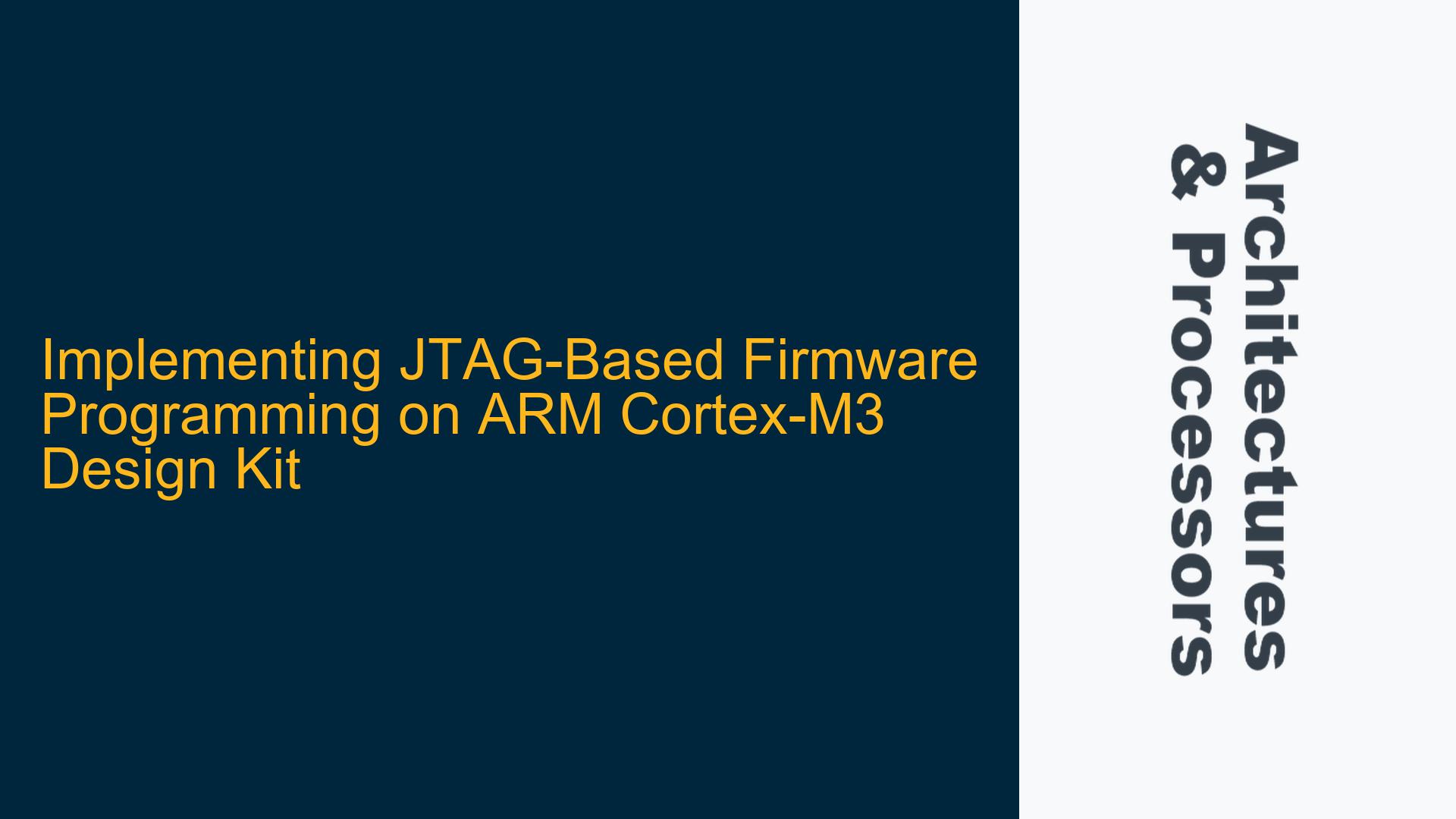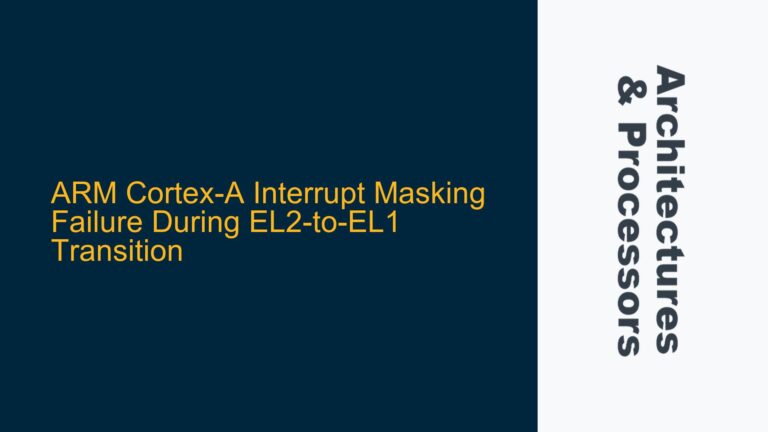JTAG Firmware Programming on Cortex-M3: Key Considerations and Challenges
When implementing JTAG-based firmware programming on an ARM Cortex-M3 Design Kit, several critical factors must be considered to ensure a successful implementation. The Cortex-M3 processor, being a widely used embedded system core, supports JTAG for debugging and firmware programming. However, the process is not as straightforward as it might seem, especially when dealing with FPGA implementations or custom ASIC designs. The primary challenge lies in the absence of embedded flash memory in FPGA environments, which necessitates alternative approaches such as using SRAM or external flash memory. Additionally, the integration of JTAG-based programming requires a deep understanding of the AHB (Advanced High-performance Bus) protocol, memory interfaces, and the specific tools used for programming, such as Keil MDK.
The Cortex-M3 Design Kit typically includes an AHB-to-SRAM wrapper, which is essential for interfacing the processor with the memory subsystem. However, the lack of embedded flash in FPGAs means that the firmware must be loaded into SRAM or external flash memory. This introduces complexities related to memory access speeds, boot sequences, and the need for custom memory controllers. Furthermore, the JTAG interface must be properly configured to support firmware programming, which involves understanding the debug access port (DAP) and the specific commands required for flash programming.
Memory Subsystem Configuration and JTAG Integration
One of the primary challenges in implementing JTAG-based firmware programming on the Cortex-M3 Design Kit is configuring the memory subsystem to support the desired functionality. In FPGA environments, embedded flash memory is typically unavailable, which means that alternative memory solutions must be employed. The most common approach is to use the FPGA’s internal SRAM (block RAM) for storing the firmware. This requires the use of an AHB-to-SRAM wrapper, which is usually included in the Cortex-M3 DesignStart bundle. The wrapper facilitates the connection between the Cortex-M3 processor and the SRAM, enabling the processor to execute code directly from the SRAM.
However, using SRAM for firmware storage has its limitations. SRAM is volatile, meaning that the firmware must be reloaded every time the FPGA is powered on. This can be mitigated by using an external non-volatile memory, such as QSPI flash, to store the firmware. The firmware can then be loaded into the SRAM during the boot process. This approach introduces additional complexity, as it requires the design of an AHB-to-external-flash interface and the implementation of a bootloader to transfer the firmware from the external flash to the SRAM.
The JTAG interface plays a crucial role in this process, as it is used to program the external flash or SRAM with the firmware. The Keil MDK debugger, for example, can be used to download the firmware image to the SRAM or external flash. However, this requires careful configuration of the debugger settings to ensure that the firmware is correctly programmed. In the case of external flash, the JTAG interface must also support the specific commands required for flash programming, such as erase and write operations.
Optimizing Memory Access Speeds and Boot Sequences
Another critical aspect of implementing JTAG-based firmware programming on the Cortex-M3 Design Kit is optimizing memory access speeds and boot sequences. The choice of memory technology has a significant impact on the performance of the system. Embedded flash memory, when available, offers faster access times compared to external flash memory. However, in FPGA environments, embedded flash is typically not an option, and external flash memory must be used instead.
External flash memory, particularly QSPI flash, tends to have slower access times due to the serial interface. This can be mitigated by using a cache or prefetch buffer to reduce the latency of memory accesses. Some QSPI flash controllers include built-in caching mechanisms that can significantly improve performance. However, the design of the memory interface must take into account the specific characteristics of the flash memory, such as the access time and the number of clock cycles required for read and write operations.
The boot sequence is another area that requires careful consideration. In a system with external flash memory, the bootloader must be designed to load the firmware from the external flash into the SRAM. This involves configuring the memory controller to handle the transfer and ensuring that the bootloader is executed before the main application. The bootloader must also be able to handle potential errors, such as corrupted firmware images or failed memory accesses.
In addition to the boot sequence, the memory map of the system must be carefully designed to ensure that the firmware is located at the correct address. The Cortex-M3 processor expects the reset vector to be located at address 0x00000000, which means that the bootloader or the firmware must be placed at this address. This can be achieved by configuring the memory controller to map the appropriate memory region to address 0x00000000 during the boot process.
Implementing JTAG-Based Firmware Programming: Step-by-Step Guide
To implement JTAG-based firmware programming on the Cortex-M3 Design Kit, follow these steps:
-
Configure the Memory Subsystem: Determine the type of memory to be used for firmware storage. In FPGA environments, this will typically be SRAM or external flash memory. If using SRAM, ensure that the AHB-to-SRAM wrapper is correctly configured. If using external flash, design an AHB-to-external-flash interface and implement a bootloader to transfer the firmware from the external flash to the SRAM.
-
Set Up the JTAG Interface: Configure the JTAG interface to support firmware programming. This involves setting up the debug access port (DAP) and ensuring that the JTAG interface supports the necessary commands for flash programming. If using Keil MDK, configure the debugger settings to download the firmware image to the SRAM or external flash.
-
Optimize Memory Access Speeds: If using external flash memory, implement a cache or prefetch buffer to reduce the latency of memory accesses. Configure the memory controller to handle the specific characteristics of the flash memory, such as the access time and the number of clock cycles required for read and write operations.
-
Design the Boot Sequence: Implement a bootloader to load the firmware from the external flash into the SRAM. Ensure that the bootloader is executed before the main application and that it can handle potential errors, such as corrupted firmware images or failed memory accesses.
-
Configure the Memory Map: Ensure that the firmware is located at the correct address in memory. The Cortex-M3 processor expects the reset vector to be located at address 0x00000000, so configure the memory controller to map the appropriate memory region to this address during the boot process.
-
Test and Debug: Once the firmware programming process is implemented, thoroughly test the system to ensure that the firmware is correctly loaded and executed. Use the JTAG interface to debug any issues that arise during the boot process or firmware execution.
By following these steps, you can successfully implement JTAG-based firmware programming on the ARM Cortex-M3 Design Kit, even in FPGA environments where embedded flash memory is not available. This approach ensures that the firmware is correctly loaded and executed, while also optimizing memory access speeds and boot sequences for optimal performance.






